Top News
January 27, 2020 Ryukyu Shimpo
How many accidents will it take before we see real “prevention of reoccurrence”?
On the afternoon of January 25, a U.S. military MH60 helicopter crashed in the sea roughly 174 kilometers to the east of Naha Airport.
This is the 51st crash since Okinawa returned to Japan in 1972.
After each crash, the U.S. military and Japanese Ministry of Defense talk about “preventing a reoccurrence,” but repeat the reckless act of resuming aircraft operations before investigating the accident and uncovering where responsibility lies.
This situation is intolerable for Okinawans, who live side by side with U.S. military bases on this small island and spend every day of their lives with U.S. military aircraft flying overhead.
The aircraft that crashed was assigned to the Blue Ridge ship of the U.S. Navy’s 7th Fleet, which is based at the U.S. naval base in Yokosuka, Kanagawa. However, helicopters of the same type have been repeatedly witnessed engaging in training over the U.S. military’s Northern Training Area (NTA) spanning from Kunigami to Higashi, as well as over former NTA land that has been returned to Japan.
Blue Ridge, which carried the helicopter that crashed, was not observed to have called at any port in Okinawa, but was supposedly anchored off the east coast of Okinawa Island.
Shortly after 5 p.m. on the same day, the Okinawa prefectural government received news of the crash from the Japanese Self-Defense Forces. Fortunately, the five crew members on the helicopter survived.
The U.S. military said that the MH60 was involved in “routine operations” at the time of the crash, and has not revealed any details.
Around Okinawa, a vast area of 54,937 square kilometers of sea, 27 areas including Area Hotel/Hotel, are provided to the U.S. military as training waters.
What kind of training the U.S. military carries out there is entirely hidden from public knowledge. To Okinawans, this constitutes a true black box.
Moreover, the Ministry of Defense describes the accident not as a “crash” but as a “water landing.”
The MH60 does not function as a seaplane and by definition cannot perform a “water landing.” The U.S. military’s official announcement states that the helicopter “went down,” implying a fall or crash, yet the Japanese government still chose this wording.
Its response calls to mind the MV22 Osprey crash near Abu, Nago in December 2016.
When the Osprey washed up a wreck on the shore with its nose broken off and its wings nowhere to be seen, the Ministry of Defense explained that it had carried out an “emergency landing,” a phrase it revised to “emergency water landing” when it was pointed out that the Osprey had gone down in the water.
It is hard to stomach the government’s attempt to minimize the issue. Its description of the present crash as a “water landing” has the same intent.
Since the day of the accident, the U.S. Navy has been carrying out Japan-U.S. joint training exercises with the Japan Ground Self-Defense Forces at its Blue Beach training area in Kin and over the waters around Okinawa.
These exercises are suspected of being related to the crash, but a representative of the Ground Self-Defense Forces asserted there is “no relationship,” and the exercises continue.
It has been pointed out that U.S. military aircraft have been aging since the military budget reduction in 2013, and this could be a cause of increased accidents.
Okinawans are the ones threatened by this increase in accidents, and the ones who will suffer the costs.
Japan and the U.S. are continuing their joint exercises in spite of the occurrence of this accident; they should stop the exercises and focus their efforts on uncovering the cause of the accident and informing the public.
(English translation by T&CT and Sandi Aritza)
Go To Japanese
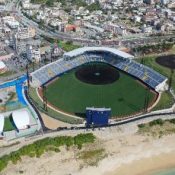
January 26, 2020 Ryukyu Shimpo
Nago – The Nago City Baseball stadium (Tapic Stadium Nago), had an opening ceremony January 25, hosted by the city and stadium management.
The ceremony was attended by people from the city government and members of the community, as well as representatives from the Hokkaido’s pro baseball team, the Nippon-Ham Fighters, who will start their spring training camp at the stadium February 1.
The stadium was constructed after the old stadium, which opened in 1977, was demolished.
The new stadium can hold 7,300 spectators, 1.8 times the capacity of the old stadium.
The Nippon-Ham Fighters were pioneers in coming to Nago for spring training for the first time in 1979, laying the foundation for what would blossom into the much larger pro baseball spring training today.
The fighters have been holding their initial camp in Arizona since 2016 when the stadium closed for repairs, but they will resume their Nago camp this year.
At the opening ceremony, Nago mayor Taketoyo Toguchi said in his greeting, “I expect [the stadium] to serve as a representation of the celebratory mood here as we prepare to celebrate the 50th anniversary of the city in August.
Fighters’ team president Koji Kawamura said, “I hope to report back to the people of Okinawa that we have conquered the league and become the best in Japan.”
Hideki Kuriyama, the team’s manager, said in a video message, “We must win at all costs, and bring joy to you all.”
(English translation by T&CT and Sam Grieb)
Go To Japanese
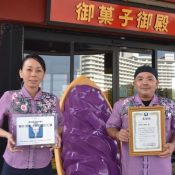
January 22, 2020 Ryukyu Shimpo
Yomitan – The 2019 “Top 100 Pro Selection for Tourism, Food, and Souvenirs,” a list voted for by travel companies nationwide in Japan, have selected Okashigoten (Hideki Takushi, CEO) in Yomitan as the best souvenir store in Japan.
The store first broke into the top 10 in 2011, and has been steadily climbing in rank since, although this is their first time taking the top spot.
This is the first such accomplishment in Okinawa, and CEO Hideki Takushi happily commented, “It has taken a long time to get the company on the right track since its founding 40 years ago, and I am happy that it has been recognized.
I want to continue making products that not only tourists, but also Okinawans are happy to get.”
The “Pro Selection” is run by the Ryoko Shimbun (Travel Newspaper) once a year, for which they distribute ballots to each department and branch of Japan’s travel companies, roughly 16,000 locations in total, and ask them to vote for businesses and tourism-related facilities for the categories of service, cooking, facilities, and project, after which they tally the votes.
On January 17, they held an award ceremony at a hotel in Tokyo.
Okashigoten’s flagship product is their “original purple sweet potato tart,” and their lineup includes a variety of sweets that heavily feature the use of Okinawan-produced purple sweet potatoes.
Additionally, the storefronts are designed to resemble famous Okinawan places such as Shuri Castle and Shurei Gate, making for a highly regarded store with products and facilities that leave a lasting impression that can only be found in Okinawa.
Akiyo Komesu, head of the company’s marketing department’s sales and business development division analyzed that part of the reason for the selection was, “successfully creating an environment with open communication and carefree exchanging of ideas,” when developing a new product or putting together a new venture.
(English translation by T&CT and Sam Grieb)
Go To Japanese
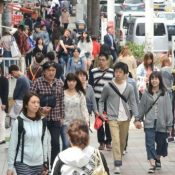
January 24, 2020 Ryukyu Shimpo
The Okinawa Prefecture Department of Culture, Tourism and Sports announced on January 23 that the prefecture welcomed 10,163,900 tourists in 2019, a 3.2% increase (or 316, 200 visitors) from the previous year.
The record growth in tourist arrivals for a seventh consecutive year, albeit the drop in visitors from Korea amidst a worsening Japan-Korea relationship, is attributed to the increase in cruise ship port calls, healthy travel demands over the long holidays, and the opening of the new Shimojishima Airport Terminal.
The prefecture welcomed 10,004,300 visitors during the 2018 fiscal year (April 2018-March 2019), surpassing the 10 million mark in one calendar year (January-December) for the first time ever.
Of all the visitors, 7,233,900 were domestic tourists—a 4.2% (290,000 visitors) increase year on year; 2,930,000 were international tourists—a 0.9% (26,200) increase, a record-breaking year for both.
Japan’s Golden Week holiday became an unprecedented 10-day holiday last year due to the national transition to a new imperial era, and for the first time ever, over 600,000 domestic tourists visited Okinawa prefecture in April alone.
The new Narita-Shimojishima flight route also boosted travel. By region, Okinawa received the most visitors from Tokyo at 3,4796,100 (a 2.7% increase year on year), followed by the Kansai region at 1,479,200 (a 5.9% increase).
Internationally, tourists from Taiwan were the most numerous at 939,700 visitors (5.6% increase year on year).
Sea and air routes between Taiwan and Okinawa were added, and visitors exceeded 900,000 for the first time ever.
China came in second at 754,200 (a 19.3% increase) which was the greatest year-on-year increase.
From Korea, only 380,000 visitors traveled to Okinawa, a 31.5% decrease year on year; a drastic drop from the record 550,000 visitors in 2018.
The prefectural government anticipates a continued increase in visitors in the 2020 Olympic year, as Naha Airport is scheduled to launch its second runway and the prefecture will host Tourism EXPO Japan 2020.
International flight routes to and from the China region and cruise ship port calls are expected to increase as well.
(English translation by T&CT and Monica Shingaki)
Go To Japanese
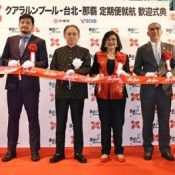
January 23, 2020 Ryukyu Shimpo
On January 22, AirAsia X, a low-cost carrier based in Malaysia, commenced regular flights between Malaysian capital Kuala Lumpur and Naha Airport.
Okinawa Governor Denny Tamaki and staff from the Okinawa Convention & Visitors Bureau greeted the maiden flight at a welcome ceremony held at the airport.
The approximately six-and-a-half-hour flight connects Naha and Kuala Lumpur via Taipei, Taiwan.
There will be four round-trips or a total of eight flights between the two cities every week.
The aircraft that will make this journey is an Airbus A330 which carries 337 passengers.
Okinawa has joined Tokyo, Osaka, Sapporo, and Fukuoka to become AirAsia X’s fifth destination in Japan.
The inaugural flight on January 22 arrived at Naha Airport at approximately 4:00 p.m. carrying 339 passengers.
AirAsia X Chairman Tan Sri Rafidah Aziz was aboard. He says, “Opening this new route will bring more tourists to the region.”
Malaysian Deputy Minister of Tourism, Arts and Culture Muhammad Bakhtiar bin Wan Chik was also among the passengers.
Governor Denny Tamaki welcomed them, saying, “I look forward to welcoming tourists who come to Okinawa from Europe and other parts of the world via Malaysia.
I want them to experience Okinawa’s culture and natural beauty.”
(English translation by T&CT and Ellen Huntley)
Go To Japanese
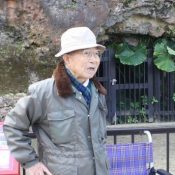
January 20, 2019 Ryukyu Shimpo
On January 19, Saneyoshi Furugen, 90, a former member of the Lower House of the Diet who was mobilized during the Battle of Okinawa in the Tekketsu Kinnotai unit composed of middle school boys, discussed his wartime experience for the first time in front of the Ryukon Cave in the grounds of Shuri Castle, to which students from the Okinawa Teachers School, who were mobilized to said unit, evacuated.
Furugen gave his testimony in front of around 60 people participating in a peace education program carried out there.
He called for the cave to be opened to the public for the purpose of peace education and said, “I want to see it used as a place for contemplation so that such a tragedy is never repeated.”
The Ryukon Cave is located behind the main hall of Shuri Castle. It was dug by students from the boy’s section of the Okinawa Teachers School during the Battle of Okinawa, and was completed in March 1945 right before the U.S. military landed in Okinawa.
After the U.S. military landed, it was used as a shelter for students of the Okinawa Teachers School who were mobilized to the Tekketsu Kinnotai unit, and a part of the cave was used for publication of the Okinawa Shimpo, a newspaper in circulation at the time.
The peace education program was arranged by the civic group Shuri Peace Committee.
Participants visited the gatepost at the former entrance to the Okinawa Teachers School, which burned down during the Battle of Okinawa, near the Okinawa Prefectural University of Arts, and other locations connected to the Okinawa Teachers School, which was located in the grounds of Shuri Castle before the war.
Furugen, who enrolled in the school in April 1944, shortly before the Battle of Okinawa, recalled the ferocity of the U.S. military’s naval bombardment, saying, “The area had been full of greenery, but not a single leaf remained.
It was utterly blasted into nothing.”
Furugen shared memories of wartime in front of the cave for about two hours, such as the memory of using pickaxes to dig the trench using a three-shift system.
“People should be allowed to visit [the cave].
I hope you will all lend your assistance so that it can serve a role in peace education,” said Furugen, emphasizing the necessity of preserving the cave and using it for peace education.
(English translation by T&CT and Sandi Aritza)
Go To Japanese
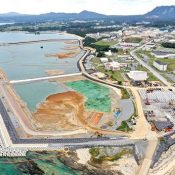
January 20, 2020 Ryukyu Shimpo Digital Edition
In his annual policy speech delivered to the Diet on January 20, Prime Minister Shinzo Abe indicated his administration’s stance on working to reduce the base burden borne by Okinawa, however since 2014 the word “Henoko,” the hot-button destination for the relocation of MCAS Futenma, has disappeared from the annual address and was not referenced.
The return of MCAS Futenma that was agreed upon by Japan and the U.S. was also not discussed. Conversely, he did mention his desire to support the rebuilding of Shuri Castle, which burned down late last year.
In the policy speech, Abe stressed, “We will continue to reduce the base burden of Okinawa while maintaining our deterrent capabilities.”
He added, “We continue to work on new facilities in our efforts to relocate the Marines to Guam in the first half of the 2020’s.”
Minister of Defense Yoshihide Suga has indicated that the Henoko relocation and the Guam relocation are “linked,” and if the Henoko relocation is delayed it could affect the move of the Marines to outside of Japan’s borders.
In this year’s address, there are some that view the reference to the Guam relocation as also directly referring to the return of MCAS Futenma to Japan.
Other Okinawa-related topics included the use of Naha Airport’s runway No. 2, where Abe stressed, “By expanding the landing and takeoff slots to over 100,000, we hope to continue to revitalize Okinawa as the ‘Gateway to Asia.’”
He also mentioned the hosting of the Japan Cultural Expo, which with feature local culture from all over Japan including things like Ryukyuan dance.
(English translation by T&CT and Sam Grieb)
Go To Japanese
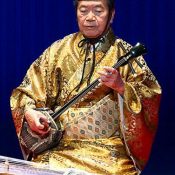
January 21, 2020 Ryukyu Shimpo
The “Bank of the Ryukyus Presents Ichio Nakamura in Shigei—Living National Treasure-Designation Celebration Concert” was held on January 20 at the Okinawa Convention Center Theater, hosted by Ryukyu Shimpo, co-hosted by the Okinawa Performance Arts Association (Okinawa Geinou Renmei) and the Nomura School of Ryukyu Classical Music Preservation Association, with special cooperation from the Bank of the Ryukyus.
Nakamura earned the Nationally-Designated Important Intangible Cultural Property status (Individual Certification) in traditional Ryukyuan music last year.
During the celebratory concert, he took the stage with fellow Living National Treasures Choichi Terukina, Tokutaro Shiroma, Noho Miyagi, Kishun Nishie and Satoshi Higa.
The audience of about 1,300 applauded the commensurate artists.
The celebratory concert opened with a spectacular unison ensemble of traditional Ryukyuan music, followed by a performance of Maé no Hama by six artists designated Living National Treasures.
The crowd also enjoyed 21 song and dance performances.
In the finale, three Living National Treasures shared the stage and sang Sho Chiku Bai Tsuru Kamé in succession. Nakamura closed the show with Tsuru Kamé Bushi.
Nakamura, who gave a solo singing performance of Jyanna Bushi with lyrics that thanked those who have supported the art, renewed his motivation and commented, “From this day forward, I want to get back to the basics and continue to work on myself.”
(English translation by T&CT and Monica Shingaki)
Go To Japanese
![[Exclusive Interview] Former President of Catalonia Puigdemont discusses Okinawa, says ignoring popular will is a mistake](http://english.ryukyushimpo.jp/wp-content/uploads/2020/01/f90fbf4b20bb5954349f6522da84ab0d-1-175x175.jpg)
January 5, 2019 Ryukyu Shimpo
Takahiro Miyagi
On January 4, the Ryukyu Shimpo interviewed Carles Puigdemont, age 57, former President of Catalonia who has been charged with sedition and other acts for carrying out a referendum regarding Catalonian independence in October 2017, in Belgium, where he resides.
When asked his thoughts on the fact that the Japanese and U.S. governments are ignoring Okinawans’ opposition to the construction of a new military base in Henoko, Nago as part of the relocation of U.S. Marine Corps Air Station Futenma, as expressed in a prefectural referendum in February of last year, Puigdemont said, “It’s a mistake not to lend an ear to the will of the people.
Respecting the result of a referendum is a rule of democracy. It is the government’s duty not to ignore it and to engage in political dialogue.”
The Ryukyu Shimpo interviewed Puigdemont through an introduction by Okinawa International University professor Masaki Tomochi, who is in Catalonia for training.
Puigdemont said he “is aware” of the fact that more than 70% of U.S. military exclusive-use facilities in Japan are located in Okinawa.
Just as the Japanese national government and Okinawan prefectural government continue to wage a battle in court regarding the Henoko new base construction, Spain’s national government has also brought legal action against Puigdemont and other former members of the Catalonian government, bringing a political issue to the courtroom.
Regarding this matter, Puigdemont said, “International society has warned the Spanish government that it must ensure judiciary independence.
The fact that political interests and the judiciary are still linked is a negative legacy of the era of dictatorship. It is an impediment to democratic progress.”
“We must join hands in the face of state oppression and work so that we ourselves can decide our own future,” Puigdemont said, mentioning Okinawa and Quebec, Canada as other regions where the government is violating people’s self-determination.
Puigdemont was elected President of Catalonia in 2016. The Catalonian referendum on October 1, 2017 saw 90.18% of voters in favor of independence, with a 43.03% voter turnout.
The Spanish government charged Puigdemont and other then-members of the Catalonian government with sedition on the grounds that the referendum violated the constitution.
In October 2019, the court ordered an unsuspended sentence of 9 to 13 years incarceration for the former members of the Catalonian government.
Puigdemont fled to Belgium in October 2017, and the Spanish government issued a European Arrest Warrant against him. Meanwhile, Puigdemont was elected as a member of the European Parliament in May 2019, and while the Spanish government refused to recognize his appointment, the European Court of Justice issued a ruling on December 20, 2019 recognizing the validity of his election.
(English translation by T&CT and Sandi Aritza)
Go To Japanese
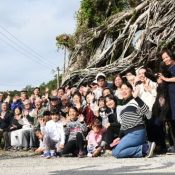
January 12, 2020 Ryukyu Shimpo
On January 4, prior to felling the “Gajimaru of Oura Asagi Garden”, which is a gajumaru tree (Ficus microcarpa) that has aged more than 120 years, a memorial service was held at Asagi Garden (in the public square in front of the public hall) in Oura Ward, Nago City to express gratitude to the tree.
Ward residents and former ward residents gathered to offer incense burning, reminisce about the gajumaru tree, and express gratitude to it.
This gajumaru tree has suffered from “minami negusare byo” (brown root rot disease) for the past several years, and due to risk of collapse, Oura Ward has made the decision to fell the tree.
The felling was scheduled for mid-January. In 2006 the gajumaru tree was designated as a city-designated cultural property (natural monument).
The public square where the gajumaru tree is located has become the grounds for community events, including eisa and village dances.
At the memorial ceremony, items such as photographs of the tree before its illness and pictures drawn by children were displayed.
Attendees yearned for a time when the tree’s leaves were bright green and grew thickly. At the memorial ceremony, head of Oura Ward Tatsuyuki Miyazato said, “Ward residents held discussions [due to the illness], and it has come to felling this beloved tree; we want to express our affection and offer the burning of incense”.
Kunizo Higa, 89, took the podium and said, “It is tragic that we must part ways”.
Kairu Shimabukuro, 14, an 8th year student at Ryokufu Gakuen, expressed his gratitude with the words, “Although I feel sad, there is also a sense of ‘you must be tired after more than 100 years'”.
(English translation by T&CT and Erin Jones)
Go To Japanese
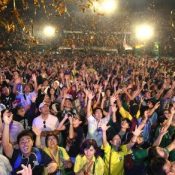
January 17, 2020 Ryukyu Shimpo
Governor Denny Tamaki announced during a regular press conference on January 16 that the 7th World Uchinanchu Festival is planned to be held October 28-31, 2021.
The governor encouraged world-wide participation and support: “the festival unites uchinanchus (Okinawans) globally, and provides an opportunity to demonstrate the Okinawan chimugukuru (spirit) to the world.
We will work to further the preservation effort and expansion of the global uchinanchu network.”
The 7th World Uchinanchu Festival is scheduled to fall on October 30, which was declared World Uchinanchu Day during the previous festival.
Okinawa’s prefectural government will appoint an executive committee during the next fiscal year and begin preparations for the event.
The World Uchinanchu Festival first launched in 1990 and has successfully followed up with six festivals. The 6th World Uchinanchu Festival attracted a record 7300 attendees.
(English translation by T&CT and Monica Shingaki)
Go To Japanese







![[Exclusive Interview] Former President of Catalonia Puigdemont discusses Okinawa, says ignoring popular will is a mistake](http://english.ryukyushimpo.jp/wp-content/uploads/2020/01/f90fbf4b20bb5954349f6522da84ab0d-1-175x175.jpg)


 Webcam(Kokusai Street)
Webcam(Kokusai Street)


